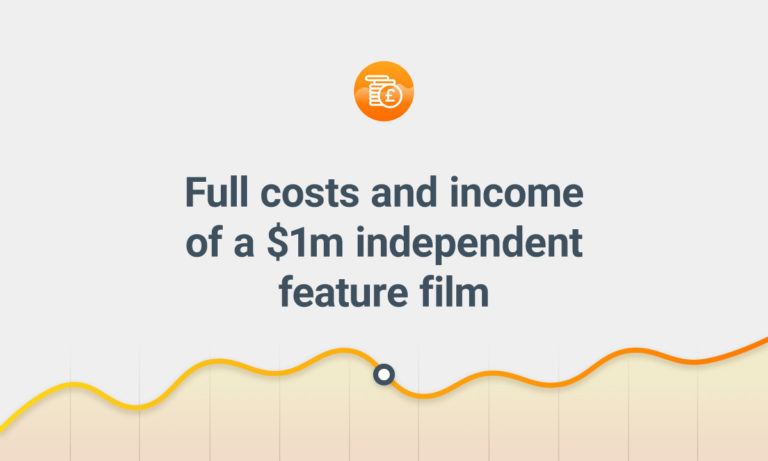 The BFI have published the latest version of their annual publication, the BFI Statistical Yearbook 2013, which focuses on data collected in 2012.
The BFI have published the latest version of their annual publication, the BFI Statistical Yearbook 2013, which focuses on data collected in 2012.
You can download the full 254 page report here at www.bfi.org.uk/education-research/film-industry-statistics-research/statistical-yearbook I’ve gone through and picked out what I regard as the 49 most interesting nuggets about the UK Film Industry. 
1. Women only made up 13% of screenwriters and 8% of directors. Both figures are lower than 2011 (19% and 15% respectively).
2. The BFI awarded £1m to short films in 2012.
3. 200 films passed the Cultural Test in 2012 to become officially ‘British’. Of these, 13 were official co-productions.
4. On average, films passing the Cultural Test were able to class 71% of their total budget as ‘Production Costs’ for the Tax Credit (which provides 20% of the eligible Production costs, on films under £20m). The figure for official Co-productions is 60% of the budget.
5. The largest government body to provide funds to the UK film industry is the taxman. HMRC provided £214m towards UK films, which is 55% of the total amount invested in the UK film industry in 2012. The BFI provided £87m (via Lottery funding) and two public broadcasters were the next biggest investors (Film4 £15m and BBC Films £12m). 
6. ‘Alan Partridge: Alpha Papa‘ received £500,000 in BFI Lottery funding.
7. Only 7% of UK films made between 2003-10 were profitable. (The BFI estimate profitability by “using an international box office to budget ratio of 2 or more”). 8. In 2012, the largest production companies were (in order and with their number of films and estimated combined budgets in brackets):
 Working Title Films (12 films, £250m total budget)
Working Title Films (12 films, £250m total budget)- Press On Features (9 films, £12m total budget)
- Black and Blue Films (9 films, £5m total budget)
- Vertigo Films (7 films, £18m total budget)
- Passion Pictures (7 films, £8m total budget)
9. There were 4,600 students in film-related higher education courses, an increase of 209% on 2011.
10. Half of the top 20 global box office successes of the last 12 years are based on novels by UK writers. Which is great news for UK writers, until you consider that all but one of those authors are dead — five were written by JK Rowling, three by JRR Tolkien and one each by Ian Fleming and Lewis Carroll. 
11. 80% of all the writers and directors the BFI has tracked in the last ten years have only ever been involved with one independent feature film. This is pretty depressing, although there is some minor good news in the way they collect this data. They only look at UK independent films, so someone like Gareth Edwards (first feature was indie ‘Monsters‘ and is now making ‘Godzilla‘) would fall into that 80%.
12. London has 55% of the UK film industry as a whole but only 30% of the distribution companies. 
13. In 2012 there were 78 million rentals of feature films on physical discs (down 9% on 2011). Interestingly 54% were by post, meaning DVD rental shops are not dead yet. Average rental costs £2.94
14. Video on Demand (VoD) in the UK film industry has doubled in size since 2011, now making up a larger share than physical rentals (£229m for rental and £243m for VoD).
15. 25% of Internet users over 12 years old have downloaded or streamed a feature film online. 
16. The film industry provided £3.8bn to UK GDP in 2012.
17. Only 2% of films screened on Sky Movies were of UK origin.
18. 647 films were released in 2012, making an average of 12 a week.
19. Foreign language films made up 35% of films by number but only 2% of box office.
20. Audience is getting older – the 45+ age bracket represented 36% of total audience over 15 years old.
21. Independent films made up 9% of total box office. 
22. 3D is becoming less popular. In 2012 43 3D films were released compared with 47 in 2011. The takings for 3D films fell from 20% of the box office in 2011 to 18% in 2012. The BFI says: “Initially audiences were attracted by the novelty of the new technology, but have become more selective about the films they watch in 3D, and choose 3D where the effect makes a perceived contribution to the experience”.
23. Sequels and franchises accounted for 13 out of the top 20 films (by both number of releases and total box office).
 24. ‘Titanic’ regained its top-spot as the highest grossing film in the UK since 1975 (adjusted for inflation), thanks to its 2012 3D re-release. ‘Skyfall’ is at number two and ‘Avatar’ at number three.
24. ‘Titanic’ regained its top-spot as the highest grossing film in the UK since 1975 (adjusted for inflation), thanks to its 2012 3D re-release. ‘Skyfall’ is at number two and ‘Avatar’ at number three.
25. Action accounted for only 7% of releases but earned 28% of the box office. Conversely, drama accounted for 24% of releases but shared only 2% of total box office.
26. The BFI claims that 647 films were released in UK cinemas but, as with every year in the last decade, their numbers do not match the BBFC official figures. The BBFC rated 718 films in 2012 whereas the BFI only have 632 films with certificates (15 were screening without a rating) in their data, leave 86 films… missing. These films might have been rated and not released but this seems high; It costs around £1,000 to get a BBFC rating for a feature film and you can’t carry that cinema rating on the DVD (it must be re-rated). I wrote about this in my previous blog post ‘Raters Gonna Rate’ and since then the BBFC replied, saying they can’t account for the discrepancy and no word yet from the BFI. 
27. UK independent films made up 8% of the New Zealand box office, thanks mostly to ‘The Best Exotic Marigold Hotel‘.
28. UK films accounted for 15% of global box office. UK independent films accounted for under 2% of global box office.
29. UK films represented 9% of releases in North America (USA and Canada) and 16% of North American box office. That sounds pretty good, but remember that this includes the likes of ‘Skyfall’, rather than just independent films. 
30. The largest single BFI investment was £1.6m in ‘The Invisible Woman‘.
31. Only 22% of films with budgets under £500,000 made between 2003-10 were released theatrically within two years. For budgets over £500,000 it rises to 57%.
32. Estimated total spent by UK distributors on marketing was £189m. Of that, £89m was on TV adverts, £67 on outdoor (posters, buses, tube, etc), £22m press, £7m on radio and £4m online.
33. 90% of UK cinemas screens have digital projection.
34. 60% of releases are shown at fewer than 50 sites with 4% being shown at over 500 sites.
35. On average films budgeted under £500,000 cost £40,000 to distribute theatrically, films budgeted under £2m cost £200,000 and films with budgets over £10m cost an average of £2,400,000 to bring to the cinema. 
36. For the first time since 1984 the net increase in traditional screens was larger than the net increase in multiplex screens.
37. There were 3.9 billion viewings of feature films on TV in the UK in 2012. This is 22 times the number of cinema admissions.
38. The UK has the third largest filmed entertainment market in the world, after America and Japan.
39. DVD and Blu-Ray sales are only marginally larger income generators than cinemas (£1.2bn for physical retail compared with £1bn for theatrical admissions). The total filmed entertainment market is worth £4bn. 
40. ‘Salmon Fishing in the Yemen‘ had a larger-than-average share of over 45 year olds. The largest audience group for ‘The Pirates In An Adventure with Scientists‘ was the 25-44 age group.
41. In 2012, £929m was spent on productions in the UK film industry, £345m less than the £1.3bn spent in 2011. In part, that is because the number of films made has dropped from 331 in 2011 to 249 in 2012.
42. Between 2008-10 there was a 49% rise in films made on a budget of under £500,000. In 2012, there were 249 films made on under £500,000, which is significantly less than the peak of 358 in 2010. The BFI does acknowledge that they have a hard time tracking micro-budget films, so these numbers are likely to underestimate the total, but the trend can reasonably be assumed to be accurate. 
43. Just nine big-budget films accounted for 65% of the total UK film industry production spend, including ‘All You Need Is Kill‘, ‘Fast & Furious 6‘, ‘Jack Ryan‘, ‘Maleficent‘ and ‘Rush‘.
44. The median budget of domestic UK films was £200,000 (same as 2011). The inward investment feature median budget fell from an “unusually high” £18.7m in 2011 to £9.7m in 2012. The median budget for a co-production was £1.8m.
45. 70% of total UK film investment went into production, and production makes up 61% of Lottery funding awards.
46. In 2012, there were 5,190 film production companies in the UK. This figure may be high partly due to special purpose vehicles (SPVs) set up for a single film and kept running for tax purposes.
47. In addition there were 1,470 video production companies, 2,205 in post-production, 475 in film/video distribution and 205 in film exhibition.
48. Of the 392 film companies that made a feature in 2012 only 10 made three or more, 19 made two and the rest only made one.
49. 47% of people working in film and video industry are freelance.





Comments
Great list, thanks for pulling it together.
Do you have any thoughts on the ratio between the film budgets and the spend to get to the cinema (point 35)?
Hi Peter,
Good question. Our industry is an uncertain one and consequently studios, sales agents, distributors and exhibitors gravitate towards certain metrics to guess the value of a film. The film’s budget is one such metric – smaller films will be perceived as more risky and larger fare will give an air of confidence.
In an ideal world there would be no link between a film’s budget and the amount they spend to bring it to screen. Cinema tickets cost the the public the same to watch in the cinema, no matter if it’s ‘Prometheus’ or ‘Primer’ and cinemas have fixed running costs. The public want to watch good stories told well and don’t care much for how the movie was made or what the final budget was.
But we don’t live in a perfect world. We live in a world where larger marketing budgets mean larger audiences and where the man six Studios can throw their weight around. Larger budgets allow for enticing effects and famous faces.
Distribution costs are weighted in favour of the larger players. Case in point: the Virtual Print Fee (VPF). The VPF came about after distributors lobbied cinemas to pay for new digital projectors. The cinemas pointed out that they would be shouldering most of the cost but it was the distributors who would reap the benefits from not having to create and ship bulky 35mm prints. So they created a fee that distributors pay on top of everything else to have their films screen digitally.
That’s all well and good but the devil is in the detail. The VPF is currently £675 for each week you’re screening your movie. It’s one VPF for the week, no matter how many times you screen it. So if you screen your indie movie on a Tuesday night it’ll cost £675 and if Harry Potter is shown 30 times that week the total cost is £675. It’s a regressive tax, favouring the larger players.
Stephen
Hi,stephen I want to ask u few questions.1.what is the difference between bolted and UK film industry.2. which is the world’s most reputed film industry.3. what’s about bolywd- the largest film industry.
Hi Stephen,
Many thanks for this. I too spent much time going through the FCUK research materials, which I found to be, in comparison with say Denmark, obfuscatory to say the least.
Their recent report on female writers, directors, etc is an obvious case in point. It concludes with an appendix on ‘profitability’, coming up with the interesting formula that a UK independent film which makes twice its budget for 12 major territories (including the US) ends up in profit as far as the investors are concerned. As they say – theatrical performance is a pretty good indicator of how well a film does in TV, rental, DVD, VOD, and whatever other markets. They also comment about how hard it is to obtain actual hard data.
However they fail to list the revenues made by even one single UK independent film, or what percentage even many to achieve theatrical sales across twelve territories.
Perhaps we can look elsewhere, and solve this mystery at the same time. The UKFC for ten years was a major investor – hence, according to this report, a UK independent film would need to do more than 2x its budget on theatrical etc. for the UKFC to at least recoup its investment. When the UKFC was closed down the Guardian found that this had happened on three occasions – yep, three films re-couped their costs, and one of those was the documentary, “Man on Wire”.
Hence one can conclude that virtually all recipients of UKFC funding, whether male or female, did not receive that funding on the basis of their ‘bankability’.
The systemic failure of the UKFC (and now the BFI) to tackle the elephant in the room – that the UK is solely an off-shore island for US productions (note: UK ‘independent’ films only get US theatrical releases if a US distributor owns the rights). But that failure means that they remain in a position in which UK independent film production where people get paid is almost completely dependent on their patronage – yep, sycophancy and nepotism. Of course the other way of getting paid used to be by recognising that it didn’t matter if a film made any money at all – it just needed to be part of a well thought out tax avoidance scam.
Cheers
Jon Williams (writer producer “Diary of a Bad Lad” Safecracker Films and exec producer, Tash Force, also Safecracker.
Be in touch.
Hi Stephen!
Thanks for such a wonderful post. I am on a research project about film financing companies in UK. In that case, your post helps me a lot. Thanks once again and keep posting!
– Neveet
you know what i say to that? GOOD